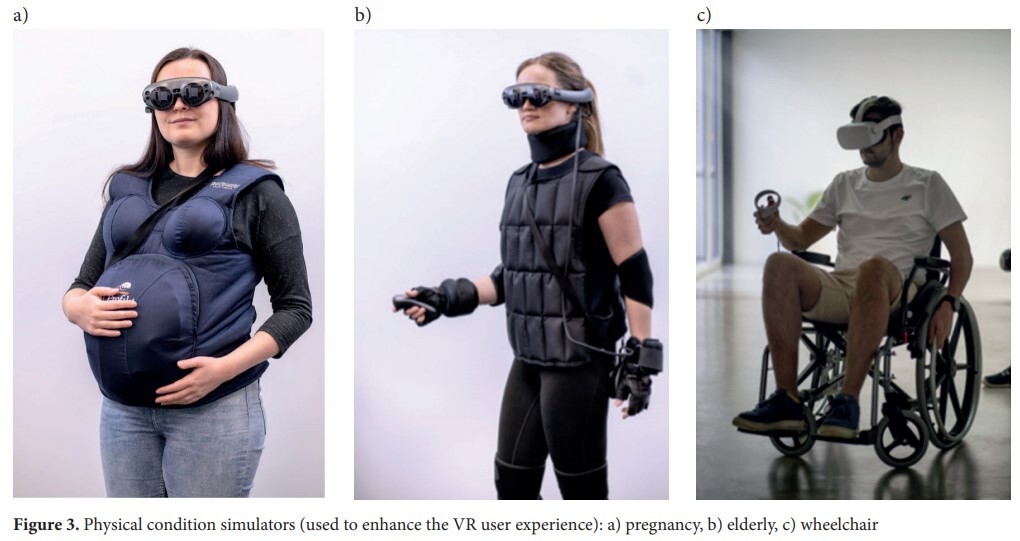Online first
Bieżący numer
Archiwum
Najczęściej cytowane 2024
O czasopiśmie
Zespół Redakcyjny
Komitet Redakcyjny
Polityka prawno-archiwizacyjna
Kup czasopismo
Klauzula informacyjna o przetwarzaniu danych osobowych
Deklaracja dostępności
Instrukcje dla Autorów
Instrukcje dla Recenzentów
Polecamy
Kontakt
Recenzenci
2024
2023
2022
2021
2020
2019
2018
2017
2016
2015
2014
2013
Redakcja i tłumaczenia
PRACA PRZEGLĄDOWA
Enhancing empathy through virtual reality: Developing a universal design training application for students
1
Lodz University of Technology, Łódź, Poland (Institute of Mechatronics and Information Systems)
2
University of Tartu, Tartu, Estonia (iCV Lab)
3
Polytechnic Institute of Porto, Porto, Portugal (School of Engineering, Department of Physics)
Data publikacji online: 07-07-2023
Autor do korespondencji
Grzegorz Zwoliński
Lodz University of Technology, Institute of Mechatronics and Information Systems, Stefana Żeromskiego 116, 90-537 Łódź, Poland
Lodz University of Technology, Institute of Mechatronics and Information Systems, Stefana Żeromskiego 116, 90-537 Łódź, Poland
Med Pr Work Health Saf. 2023;74(3):199-210
SŁOWA KLUCZOWE
DZIEDZINY
STRESZCZENIE
The lack of empathy towards disability is a significant societal issue that hampers inclusivity and understanding. Many struggle to comprehend the daily challenges and experiences faced by people with disabilities, leading to ignorance, prejudice, and exclusion. However, empathy plays a pivotal role in addressing this problem and serves as the foundation for developing and creating better products, services, and environments. This article explores the potential of developing virtual reality (VR) applications to enhance students’ empathy towards individuals with disabilities. By increasing empathy levels, students are expected to gain significant qualifications in universal design (UD). The full application development process covers the most suitable head-mounted display (HMD) set. The implementation methodology using the Unity programming platform, the approach adopted for conducting classes using the developed VR application, and the deployment stage. Testing was successfully conducted on a student population, receiving positive user feedback. Through the integration of VR technology, the authors thoroughly describe how to address the empathy gap and equip students with essential skills for inclusive and accessible design. The findings presented in this study provide valuable guidance for educators and developers interested in harnessing VR’s potential to foster empathy and advance universal design practices. With the presented methodology and proposed application, the authors demonstrate the effectiveness of VR applications in elevating students’ empathy levels, consequently enhancing their qualifications in universal design. Med Pr. 2023;74(3):199–210
Udostępnij
ARTYKUŁ POWIĄZANY
Przetwarzamy dane osobowe zbierane podczas odwiedzania serwisu. Realizacja funkcji pozyskiwania informacji o użytkownikach i ich zachowaniu odbywa się poprzez dobrowolnie wprowadzone w formularzach informacje oraz zapisywanie w urządzeniach końcowych plików cookies (tzw. ciasteczka). Dane, w tym pliki cookies, wykorzystywane są w celu realizacji usług, zapewnienia wygodnego korzystania ze strony oraz w celu monitorowania ruchu zgodnie z Polityką prywatności. Dane są także zbierane i przetwarzane przez narzędzie Google Analytics (więcej).
Możesz zmienić ustawienia cookies w swojej przeglądarce. Ograniczenie stosowania plików cookies w konfiguracji przeglądarki może wpłynąć na niektóre funkcjonalności dostępne na stronie.
Możesz zmienić ustawienia cookies w swojej przeglądarce. Ograniczenie stosowania plików cookies w konfiguracji przeglądarki może wpłynąć na niektóre funkcjonalności dostępne na stronie.






